
The Dakota, also known as the Dakota Apartments, is a cooperative apartment building at 1 West 72nd Street on the Upper West Side of Manhattan in New York City, United States. The Dakota was constructed between 1880 and 1884 in the German Renaissance style and was designed by Henry Janeway Hardenbergh for businessman Edward Cabot Clark. The building was one of the first large developments on the Upper West Side and is the oldest remaining luxury apartment building in New York City. The building is a National Historic Landmark and has been designated a city landmark by the New York City Landmarks Preservation Commission. The building is also a contributing property to the Central Park West Historic District.

A dungeon is a room or cell in which prisoners are held, especially underground. Dungeons are generally associated with medieval castles, though their association with torture probably derives more from the Renaissance period. An oubliette or bottle dungeon is a basement room which is accessible only from a hatch or hole in a high ceiling. Victims in oubliettes were often left to starve and dehydrate to death, making the practice akin to—and some say an actual variety of—immurement.
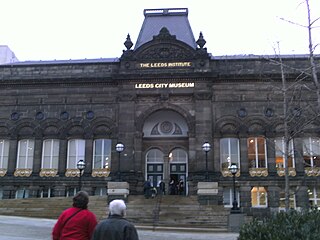
Mechanics' institutes, also known as mechanics' institutions, sometimes simply known as institutes, and also called schools of arts, were educational establishments originally formed to provide adult education, particularly in technical subjects, to working men in Victorian-era Britain and its colonies. They were often funded by local industrialists on the grounds that they would ultimately benefit from having more knowledgeable and skilled employees. The mechanics' institutes often included libraries for the adult working class, and were said to provide them with an alternative pastime to gambling and drinking in pubs.

Gray's School of Art is the Robert Gordon University's art school, located in Aberdeen, Scotland. It is one of the oldest established fine art institutions in Scotland and one of Scotland's five art schools today, and ranked among the Top 20 Schools of Art and Design in the United Kingdom. The School is housed in a modernist building at the university's Garthdee campus in Aberdeen. As well as degree-level training in fine art, applied art and design, Gray's School of Art offers short courses and evening classes to the general public in a wide variety of mediums. Many of these are designed for those with no previous formal training, and can also be used to develop a portfolio prior to applying for degree-level study. The School also mounts exhibitions, including the annual Degree Show which showcases the work of students on its programmes.

In Great Britain and Ireland, especially in the 18th and 19th centuries, assembly rooms were gathering places for members of the higher social classes open to members of both sexes. At that time most entertaining was done at home and there were few public places of entertainment open to both sexes besides theatres. Upper class men had more options, including coffee houses and later gentlemen's clubs.

The University Club of New York is a private social club at 1 West 54th Street and Fifth Avenue in the Midtown Manhattan neighborhood of New York City. Founded to celebrate the union of social duty and intellectual life, the club was chartered in 1865 for the "promotion of literature and art". The club is not affiliated with any other University Club or college alumni clubs. The club is considered one of the most prestigious in New York City.
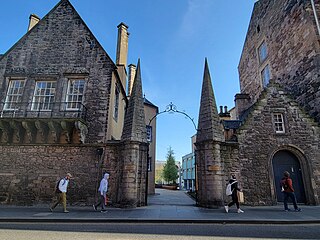
The Moray House School of Education and Sport is a school within the College of Arts, Humanities and Social Science at the University of Edinburgh. It is based in historic buildings on the Holyrood Campus, located between the Canongate and Holyrood Road.

The Hotel Pennsylvania was a hotel at 401 Seventh Avenue in Manhattan, across from Pennsylvania Station and Madison Square Garden in New York City. Opened in 1919, it was once the largest hotel in the world. It remained the fourth largest in New York City until it closed permanently on April 1, 2020. After years of unsuccessful preservation battles, it is being demolished as of 2023. The hotel is to be replaced by 15 Penn Plaza, a 68-story tower.

The Roosevelt Hotel is a former hotel at 45 East 45th Street in the Midtown Manhattan neighborhood of New York City. Named in honor of U.S. president Theodore Roosevelt, the hotel was developed by the New York Central Railroad and the New York, New Haven and Hartford Railroad and opened in 1924. The 19-story structure was designed by George B. Post & Son with an Italian Renaissance Revival-style facade, as well as interiors that resembled historical American buildings. The Roosevelt Hotel is one of several large hotels developed around Grand Central Terminal as part of Terminal City.

The Jane is a boutique hotel at 505–507 West Street, on the northeastern corner with Jane Street, in the West Village neighborhood of Manhattan in New York City. It was constructed in 1908 by the American Seaman's Friend Society (ASFS) as a sailors' boarding house called the American Seamen's Friend Society Sailors' Home and Institute. The Jane was designed by William A. Boring in the Georgian style and is a New York City designated landmark.

The Hotel Carter was a hotel at 250 West 43rd Street, near Times Square, in the Midtown Manhattan neighborhood of New York City. Opened in June 1930 as the Dixie Hotel, the 25-story structure originally extended from 43rd Street to 42nd Street, although the wing abutting 42nd Street has since been demolished. The hotel originally contained a bus terminal at its ground level, which was closed in 1957, as well as a bar and restaurant immediately above it. The upper stories originally contained 1,000 rooms but were later downsized to 700 rooms.
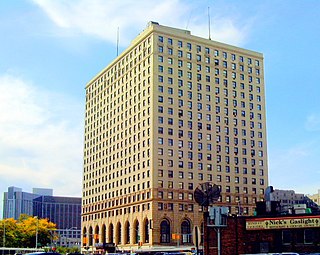
The Detroit-Leland Hotel is a historic hotel located at 400 Bagley Street in Downtown Detroit, Michigan. It is the oldest continuously operating hotel in downtown Detroit, and was listed on the National Register of Historic Places in 2005. The ballroom of the Detroit-Leland has hosted a nightclub, the City Club, since 1983. The hotel is now named The Leland and no longer rents to overnight guests.

The Beresford is a former hotel situated at 460 Sauchiehall Street, Glasgow, Scotland. It opened in 1938 to provide accommodation for those attending the city's Empire Exhibition and was often described as Glasgow's first skyscraper, being the tallest building erected in Glasgow between the two world wars, at seven storeys high. It is one of the city's most notable examples of Art Deco/Streamline Moderne architecture, and is protected as a category B listed building. The first public address by the young John F. Kennedy was delivered in the hotel in 1938.
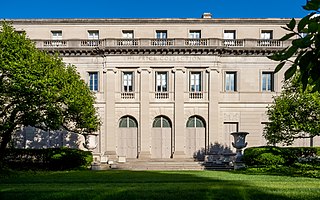
The Henry Clay Frick House was the residence of the industrialist and art patron Henry Clay Frick in New York City. The mansion is located between 70th and 71st Street and Fifth Avenue on the Upper East Side of Manhattan. It was constructed in 1912–1914 by Thomas Hastings of Carrère and Hastings. It was transformed into a museum in the mid-1930s and houses the Frick Collection and the Frick Art Reference Library. The house and library were designated a National Historic Landmark in 2008 for their significance in the arts and architecture as a major repository of a Gilded Age art collection.

The Bradford Mechanics' Institute Library was established in Bradford, England, in 1832 as part of a national initiative to provide adult education especially in technical subjects for working men. The institute in Bradford was supported by numerous local worthies, including James Hanson after whom is named one of Bradford's largest high schools.

The Osborne, also known as the Osborne Apartments or 205 West 57th Street, is an apartment building at Seventh Avenue and 57th Street in Midtown Manhattan in New York City. The original portion of the Osborne was designed by James Edward Ware and constructed from 1883 to 1885. An annex to the west, designed by Alfred S. G. Taylor and Julian Clarence Levi, was constructed in 1906. The Osborne is one of the oldest luxury apartment buildings in New York City.
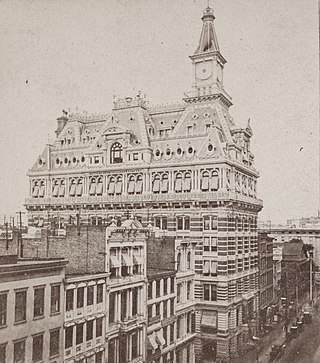
The Western Union Telegraph Building was a building at Dey Street and Broadway in the Financial District of Manhattan in New York City. The Western Union Building was built with ten above-ground stories rising 230 feet (70 m). The structure was originally designed by George B. Post, with alterations by Henry Janeway Hardenbergh. It is considered one of the first skyscrapers in New York City.

The Dunfermline Carnegie Library opened in Dunfermline, Scotland, on 29 August 1883 and was the world's first Carnegie Library funded by the Scottish-American businessman and philanthropist Andrew Carnegie. It was designed by Edinburgh architect James Campbell Walker who also designed the nearby Dunfermline City Chambers. Andrew Carnegie donated £8000 to building and stocking what would be the first of over 2,500 Carnegie Libraries. The library was made a Category B listed building in 1971.
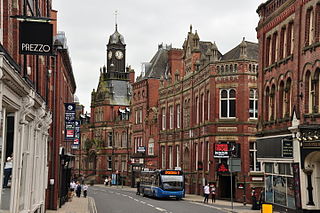
Clifford Street is a road in the city centre of York, in England.
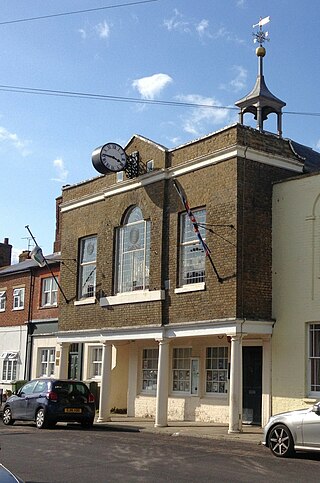
Queenborough Guildhall is a former municipal building in the High Street in Queenborough, Kent, England. The structure, which is currently used as a museum, is a Grade II listed building.





















